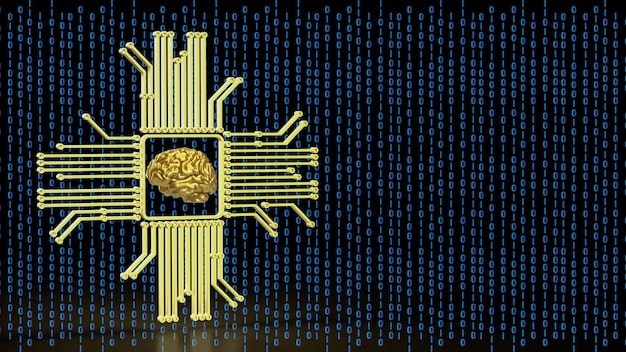AI-Driven Cyberattacks: Machine Learning’s Role in Scaling Threats

AI-driven cyberattacks leverage machine learning to automate and enhance malicious activities, enabling attackers compromise systems and networks more efficiently, resulting in significant damage.
In today’s digital landscape, the sophistication of cyber threats is rapidly evolving. Among the most concerning developments is the rise of AI-driven cyberattacks: How Machine Learning is Being Used to Automate and Scale Malicious Activities, as cybercriminals increasingly harness the power of artificial intelligence to automate and amplify their operations.
The Evolution of Cyberattacks with Artificial Intelligence
The integration of artificial intelligence into cyberattacks represents a significant leap in the threat landscape. Traditional cyberattacks often rely on manual processes and predefined rules, making them relatively predictable and easier to defend against. However, AI introduces a new level of adaptability and automation, enabling attackers to overcome these limitations.
Traditional vs. AI-Driven Attacks
Traditional cyberattacks often depend on exploiting known vulnerabilities or using social engineering to trick individuals into divulging sensitive information. These attacks typically follow a linear path and can be thwarted by up-to-date security measures. In contrast, AI-driven attacks are more dynamic and capable of evolving in response to defensive strategies.
- Traditional: Relies on known vulnerabilities and manual processes.
- AI-Driven: Adaptable and automates the discovery and exploitation of vulnerabilities.
- Impact: AI enhances the speed and scale of attacks, making them harder to detect and prevent.
Machine Learning in Cyber Offense
Machine learning algorithms can analyze vast amounts of data to identify patterns, predict outcomes, and optimize attack strategies. This capability allows attackers to automate tasks such as vulnerability scanning, malware development, and phishing campaign customization, significantly increasing their efficiency.

Automating Vulnerability Discovery
One of the most significant applications of AI in cyberattacks is the automation of vulnerability discovery. Traditionally, security researchers and penetration testers manually search for vulnerabilities in software and systems, a time-consuming process. AI can accelerate this process by automatically scanning code and networks for potential weaknesses.
AI-driven vulnerability scanners can analyze code for common vulnerabilities, such as buffer overflows, SQL injection flaws, and cross-site scripting (XSS) vulnerabilities. They can also simulate real-world attack scenarios to identify vulnerabilities that might not be apparent through static analysis.
AI-Powered Fuzzing
Fuzzing is a technique used to discover vulnerabilities by providing invalid, unexpected, or random data as input to a program. Traditional fuzzing is often a manual and repetitive process, but AI can automate and optimize it.
AI-powered fuzzing tools can learn from previous fuzzing attempts to generate more effective test cases, increasing the likelihood of discovering new vulnerabilities. These tools can also prioritize vulnerabilities based on their potential impact, helping security teams focus on the most critical issues.
- Efficiency: AI automates and optimizes the fuzzing process.
- Learning: Learns from past attempts to create more effective test cases.
- Prioritization: Helps security teams focus on the most critical vulnerabilities.
The increasing sophistication of cybersecurity threats demands advanced solutions. AI techniques, particularly in anomaly detection and threat intelligence, offer powerful tools to defend against evolving cyberattacks. However, the successful implementation of these techniques requires a strategic approach and a deep understanding of the underlying technologies.
Scaling Malware Development with AI
AI can also be used to scale malware development, making it easier for attackers to create and distribute malicious software and to customize it for specific targets. AI algorithms can generate new variants of existing malware, modify code to evade detection, and even create entirely new types of malware.
Generative Adversarial Networks (GANs) for Malware
GANs are a type of machine learning model consisting of two neural networks: a generator and a discriminator. The generator creates new data samples, while the discriminator tries to distinguish between real and fake data. In the context of malware development, GANs can be used to generate new malware samples that are similar to existing ones but different enough to evade detection by signature-based antivirus tools.
The generator network is trained to create malware samples that can fool the discriminator, while the discriminator network is trained to identify real malware samples. This process continues until the generator can create malware samples that are virtually indistinguishable from real ones.
- GANs: Generate new malware samples that evade detection.
- Efficiency: Automates the creation of new malware variants.
- Adaptability: Enables malware to evolve and adapt to defensive strategies.

Enhancing Phishing Attacks
Phishing attacks are a common type of cyberattack that relies on deceiving individuals into divulging sensitive information, such as usernames, passwords, and credit card numbers. AI can enhance phishing attacks by automating the creation of personalized and convincing phishing emails.
AI-Driven Spear Phishing
Spear phishing is a targeted type of phishing attack that focuses on specific individuals or organizations. AI can be used to analyze data about potential victims, such as their job titles, interests, and social media activity, to create highly customized phishing emails that are more likely to be successful.
AI algorithms can also generate realistic-looking fake websites that mimic the appearance of legitimate websites, making it harder for victims to distinguish between real and fake sites. By leveraging AI, attackers can create phishing campaigns that are both more effective and more difficult to detect.
Defensive Strategies Against AI-Driven Cyberattacks
As AI-driven cyberattacks become more prevalent, it is essential to develop effective defensive strategies to protect against these threats. Traditional security measures, such as firewalls and antivirus software, may not be sufficient to defend against AI-powered attacks. A multi-layered approach that combines human expertise with AI-driven security tools is needed.
One crucial aspect of defending against AI-driven attacks is to leverage AI for security purposes. AI can be used to analyze network traffic, identify anomalies, and detect malicious activity in real-time. AI-powered security tools can also automate incident response, helping security teams quickly contain and mitigate attacks.
Using AI for Threat Detection
AI excels at analyzing large volumes of data to identify patterns that humans might miss. Machine learning algorithms can be trained to detect anomalies in network traffic, user behavior, and system logs, providing early warning signs of potential cyberattacks.
AI-driven threat detection tools can also learn from past attacks to improve their accuracy and adapt to new threats. By continuously monitoring and analyzing data, these tools can help security teams stay one step ahead of attackers.
The Future of AI in Cybersecurity
The future of AI in cybersecurity is likely to be characterized by an ongoing arms race between attackers and defenders. As attackers develop more sophisticated AI-powered tools, defenders will need to respond with equally advanced AI-driven security measures.
Ethical Considerations
The use of AI in cybersecurity raises several ethical considerations. One concern is the potential for AI to be used for malicious purposes, such as creating autonomous weapons or conducting surveillance without consent. It is essential to establish ethical guidelines and regulations to ensure that AI is used responsibly in the cybersecurity domain.
- Regulations: Develop ethical guidelines and regulations for AI use.
- Transparency: Ensure AI systems are transparent and accountable.
- Collaboration: Promote collaboration among stakeholders to address ethical concerns.
| Key Point | Brief Description |
|---|---|
| 🤖 AI Automation | Automates vulnerability discovery & malware development. |
| 🎣 Enhanced Phishing | AI personalizes phishing emails, increasing success rates. |
| 🛡️ Defensive AI | AI detects anomalies and responds to cyberattacks in real-time. |
| ⚖️ Ethical Use | Ensuring AI is used responsibly in cybersecurity. |
Frequently Asked Questions
▼
AI-driven cyberattacks use artificial intelligence to automate and enhance malicious activities, like vulnerability scanning and malware development, scaling their impact efficiently.
▼
AI-powered vulnerability scanners analyze code and simulate attacks to identify potential weaknesses, accelerating the discovery process traditionally done manually.
▼
Yes, AI can personalize phishing emails by analyzing victim data, making the attacks more convincing and harder to detect.
▼
Utilizing AI for security helps in threat detection by analyzing network traffic and user behavior. AI automates incident response, defending against attacks.
▼
Ethical guidelines ensure AI use is responsible, preventing malicious use like autonomous weapons or surveillance without consent. Transparency and collaboration are essential.
Conclusion
The integration of artificial intelligence into cyberattacks presents both challenges and opportunities for the cybersecurity community. While AI can be used to automate and scale malicious activities, it can also be leveraged to enhance defensive strategies and protect against emerging threats. By understanding the ways in which AI is being used in cyberattacks, organizations can develop more effective security measures and stay one step ahead of attackers.





